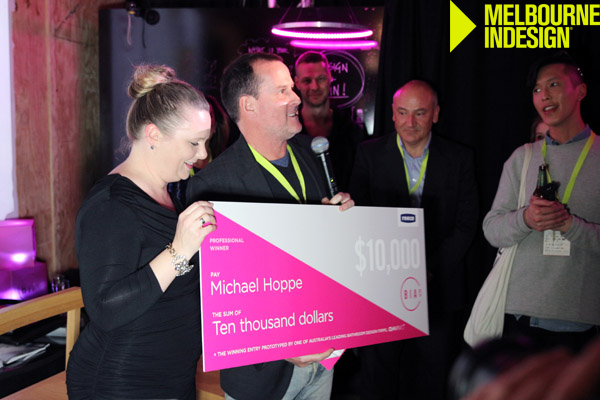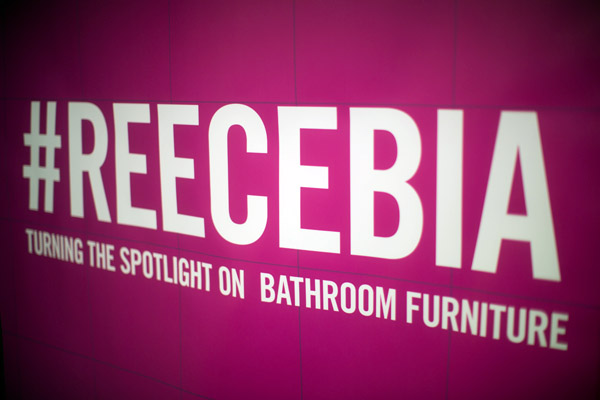Clever, compact and cohesive rethinking of the vanity unit triumphed at this year’s Reece Bathroom Innovation Award (BIA) with the careful balance of aesthetic and multi-functionality key for this year’s winners

September 2nd, 2014
The 2014 BIA professional and student winners were announced at a special ceremony at Melbourne Indesign on 22 August along with a showcase of all this year’s finalist entries.
Industrial designer and founder of Hop Design, Michael Hoppe, took out the professional category and the $10,000 prize for his compact and multi-functional cylindrical vanity unit.
Combining mirrors, sink, drawers, seat and storage into one cohesive bathroom furniture piece, its luxe surfaces subtly reference the Greek myth of Narcissus. The judges admired the versatility of the vanity unit’s compact design and its carefully considered aesthetic, highlighting that small can still prove both functional and visually striking.
Michael’s design vision was brought to life this year with a full-sized prototype created by Australian bathroom furniture specialists Omvivo, unveiled at the announcement event as part of his BIA prize.
Monash University industrial design student Queena Le won the student category for her modular vanity.
Design flexibility and the interchangeability of surfaces to create new functionality were key to Queena’s design. It features a perforated sliding grate that instantly transforms the basin into an extended bench surface, along with detachable and repositionable drawers and flat surface taps that act as shelves. This year’s judges praised the simplicity and honesty of the design and its adaptability to the ever-changing needs of users.
As well as securing a $5,000 cash prize, Queena’s BIA win will see her heading to Barcelona, Spain for a two week internship with design team at Roca, one of the world’s leading bathroom product manufacturers.
One of Australia’s most respected product design competitions, the BIA encourages and celebrates innovative bathroom design and this year challenged emerging and established designers to reinvent the vanity unit.
According to Bathroom Business Manager Daniela Santilli the bathroom furniture focus of this year’s competition is part of the BIA’s long tradition of pushing the boundaries of bathroom design.
“The vanity is a central, but often overlooked, element of the bathroom and we were eager to see how local designers could redefine and reimagine it. The response from this year’s entrants did not disappoint, demonstrating once again the exceptional level of design talent and innovative thinking that exists in Australia,” Daniela said.
This year’s BIA winners were selected by a panel representing the very best of Australian and international design including Fleur Sibbel and Wilhelmina McCarroll (Zuster), Suzie Dyson (Omvivo), Mark Tuckey, Zahava Elenberg (Move-In), Justin Wagemakers (Blue Sky Design), Shaynna Blaze, Roberto Palomba (Ludovica+Roberto Palomba) and Josep Congost (Roca). The competition is endorsed by the Design Institute of Australia (DIA).
From Greek mythology to his days on the drum kit, the inspirations behind Michael Hoppe’s BIA winning vanity unit design were many, varied, and not always what you’d expect. But core to his design was a desire to find a compact, multi-functional solution for small bathroom spaces.
“Many of the bathrooms we see marketed are palatial – bigger than lounge rooms,” said Michael. “But the reality is somewhat different. For many, houses – and their bathrooms – are getting more compact and it was important that my design reflected this.”
His BIA-winning solution was a column vanity that incorporates a built-in, gold-gilded basin, a swing out drawer and wheeled seat with hidden storage in one compact cylindrical unit. Accompanying the vanity unit is an oval mirror paired with an adjustable shaving mirror.
According to Michael, the idea started as a simple one but evolved as he explored how to incorporate more elements in the one functional, compact and visually striking vanity unit. Exploration of the meaning of ‘vanity’ saw Michael rediscover the myth of Narcissus, inspiring both the gold finish of the basin and the column structure of the entire vanity unit.
“As I added functionality, it transformed,” Michael said. “That was the key – turning one thing into many. I was looking to create something clean and simple that transforms into elements with different uses that can then be simply packed up again.”
As well as the $10,000 cash prize, as this year’s professional winner Michael’s design has been prototyped by Australian vanity unit manufacturers Omvivo, a process Michael describes as both challenging and rewarding.
“It’s such a big step from render to something real. Working with Omvivo has been really valuable and brings the product that step closer to reality.”
An industrial designer for more than 25 years, Michael has designed everything from trains and TVs to scientific equipment, sports gear and kitchen appliances. Referring to industrial design as “a calling”, Michael said he came to his career when deciding whether to become a scientist or an artist as a teen. “I found out there was this thing called industrial design. It was an epiphany.”
As well as working as an industrial designer, Michael also lectures at the University of New South Wales and University of Technology Sydney where he works to share his experience and enthusiasm with the industry’s next generation.
Michael Hoppe is an industrial designer and owner of the Sydney-based Hop Design.
An unused bathroom basin and frustration with the functional limitations of rental property vanities inspired Monash University industrial design student Queena Le’s 2014 BIA winning design, Balans.
In tackling the BIA brief, Queena says she simply tried to solve a problem she’d personally experienced and felt compelled to solve.
“My design is all about trying to create as much functional space as possible while maintaining a slim, contemporary design. The last apartment I lived in had a his/her vanity unit and I only ever used the one sink. I thought, ‘Hey, I should be using the other space’.”
The result was Balans, a double-basin modular vanity with a sliding basin grate that turns a basin into a shelf when not in use. Perforations in the grate let items placed on it dry thoroughly. The taps designed to accompany the Balans vanity create functional surfaces with the flat design allowing them to be used as shelves. Storage drawers separate from the vanity itself, allow the user to configure them to best suit the space as well as creating additional space on top of the drawers. Recognising that size is often a challenge in bathroom spaces, Queena wanted to ensure her design was functional, flexible and space-efficient. “More and more people are moving into apartments and living spaces are becoming smaller so I think clever ways to use space and flexibility in design will be the most important factors to consider in the bathroom.”
The impact of design on mood and experience was also a crucial consideration. “The vanity unit is usually the first and last thing we see every day. This [has] a tremendous influence on your mood so…it’s important to make sure it’s [an] enjoyable experience.”
According to Queena, the BIA win and internship with Roca’s design team in Barcelona, Spain taps into her two biggest passions – travel and design. “This award will open up so many new and exciting opportunities. But I think, most importantly, receiving recognition from the design industry has given me so much motivation and makes me proud of what I do,” she said. “I’m just taking every day and opportunity as it comes. As long as I get to travel and stay creative I know I’ll always enjoy what I’m doing.”
Reece
reece.com.au
A searchable and comprehensive guide for specifying leading products and their suppliers
Keep up to date with the latest and greatest from our industry BFF's!

BLANCOCULINA-S II Sensor promotes water efficiency and reduces waste, representing a leap forward in faucet technology.

Elevate any space with statement lighting to illuminate and inspire.

Within the intimate confines of compact living, where space is at a premium, efficiency is critical and dining out often trumps home cooking, Gaggenau’s 400 Series Culinary Drawer proves that limited space can, in fact, unlock unlimited culinary possibilities.

August has been a dynamic month for the creative industries, with architects and designers expanding their firms through promotions and several others embracing change through rebranding. Overall, this month has been marked by significant expansion and evolution.

Coming straight out of the latest issue of Indesign is a story that sets the tone for the magazine, and it’s all about the shifts in workplaces. Futurespace’s Angela Ferguson and international design icon Tim Kobe open our world up to new possibility.
The internet never sleeps! Here's the stuff you might have missed

Outdoor living has always been a hallmark of the Australian way of life. With a demanding climate, outdoor furniture needs to be high-performing – something Dutoit’s TUIN range, available through Australian Design & Co, delivers in spades.

The Heffron Centre in Maroubra, Sydney, stands as a testament to how authentic public art powered by collaborative project teams can transform urban spaces.